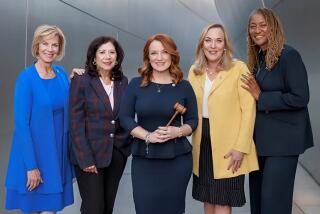Planning for a Future
Facing increased urban development pressure, Ventura County and its cities are searching for ways to enhance existing communities and preserve farmland.
To discuss new ideas, William Fulton, editor of the Ventura-based California Planning & Development Report, sat down last week with one of Southern California’s most visionary planning thinkers: Rick Cole, Southern California director of the Local Government Commission. As member of the Pasadena City Council from 1983 to 1995, Cole was credited with revitalizing Old Pasadena and helping win voter approval of the Pasadena General Plan.
Cole will be the keynote speaker at Thursday’s Ventura Planning Update at the Doubletree Hotel.
* * *
FULTON: You’ve often expressed admiration for Ventura County--both its rural landscapes and its cities and towns. What are the qualities we have that, from your view, are most important to protect?
COLE: Unless you want to be annexed by Los Angeles sprawl, you need to actively protect your agricultural industry and your individual communities. Not by resisting growth but by making clear and courageous choices to channel growth to improve your existing communities. If you allow it to bleed over the landscape, it will not only devour Ventura’s natural and agricultural beauty, it will destroy the fragile fabric of citizenship.
FULTON: You’re suggesting more growth in existing cities to preserve natural areas and working farmland. What places have managed to maintain this balance successfully, and what lessons can we in Ventura County learn from those places?
COLE: I’m talking about a return to the balance between town and countryside that we cherished in this country for a century and a half until suburbia was invented after World War II. States like Oregon, Vermont and Maryland are doing this by fostering compact, walkable communities with healthy neighborhoods and revitalized downtowns.
But in California, we run the danger of becoming fixated on the controversial issue of urban growth limits. Just drawing an arbitrary line brings problems but doesn’t produce benefits. The real lesson is to stop subsidizing outward growth and plan carefully to encourage growth that improves the quality of life and the standard of living inside existing communities.
Let me cite some obvious examples. First, we could change our codes from forbidding housing in commercial areas to encouraging it. Second, we could rewrite the parking codes that require every use to provide maximum capacity for peak demand. By promoting maximum efficiency over maximum capacity, hot and ugly parking lots can by replaced by human-scale places for more people to live and work.
FULTON: Here in Ventura County, the public seems to support good planning but appears to have lost faith in the planners and politicians to get the job done. You’re often credited with restoring the public’s faith in the planning process in Pasadena. How do you succeed in restoring faith there, and what can we learn from that experience?
COLE: Wrong question. Nobody has faith in government any more. What we did in Pasadena was restore faith in self-governance.
When we rewrote our General Plan, I insisted that we involve thousands of citizens. The professional planners thought I was crazy. First, they didn’t think thousands were interested in planning their city. Second, they feared that thousands of citizens would produce a howling mob scene. Finally, they didn’t think ordinary citizens were qualified for such a complex task.
In the end, we had 3,200 folks participate directly and thousands more through their civic, neighborhood and business groups. The result won unanimous approval from the Planning Commission and the City Council. The citizens approved it at the ballot box because the plan came from the people, not from City Hall.
FULTON: Planning sometimes seems so remote and arcane that average citizens have a hard time relating to it. How did you make the issues accessible and user-friendly to get so many people interested and involved?
COLE: Government uses all sorts of brain-dead jargon that makes really fascinating and important stuff seem dull and abstract. Most people would rather get a root canal than go to a typical government meeting.
In Pasadena, we made the connection between the real lives of people and the principles that form our General Plan. Find me a citizen who doesn’t care about whether there are jobs in town or whether their neighborhood is safe or where their children will go to school and I’ll show you a citizen who should have their pulse checked before you allow them to vote again.
It’s vital to actively market the opportunity to participate in something worthwhile and vital. It kills me that Hollywood gets people to shell out money to see the most mindless drivel yet cities can’t fill up a school auditorium to talk about a community’s future.
FULTON: You’re a strong advocate of the “livable communities” movement, which focuses on created pedestrian- and transit-oriented communities and a broader mix of activities and services at the neighborhood level. In Ventura County, most communities have been built at a suburban scale with an emphasis on privacy. How realistic is it to expect that “livable communities” ideas will make a difference here?
COLE: “Suburban scale” is planner jargon for places built for cars, not people. The problem with the way we’ve built suburbia is that you can’t get a one-pound loaf of bread without firing up a three-ton suburban assault vehicle. How many people drive to their gym to walk on a treadmill or ride a stationary bike?
There is a difference between privacy and isolation. Cities can be far more livable--far more coherent and beautiful--without anybody having to give up their privacy.
FULTON: But that would require some changes that trigger skepticism from the people who live in existing neighborhoods. Many neighborhood groups worry that redevelopment will harm residents and small-business owners. How can redevelopment be used to create effective human-scale revitalization, especially in neighborhoods outside of downtowns?
COLE: If you mean redevelopment by eminent domain and bulldozers, they have every right to be skeptical. But I learned a long time ago in politics that if you provide people with good information, they’ll make good decisions. It depends on asking the right questions and giving people a real set of choices.
You can ask neighbors: “Do you think we should let developers come in and impose massive increases in density and radical changes in use?” Who wouldn’t howl?
But what if you ask people: “Would you like to have a local store or dry cleaner close by, perhaps with an apartment on the second floor, built perhaps around a park or public square?” I guarantee you the response is going to be very different.
The Ventura Planning Update, sponsored by California Planning & Development Report, will be Thursday from 4 to 6 p.m. at the Doubletree Hotel, 2055 E. Harbor Blvd., Ventura. Admission is $10. For reservations call 655-5529.
More to Read
Sign up for Essential California
The most important California stories and recommendations in your inbox every morning.
You may occasionally receive promotional content from the Los Angeles Times.










